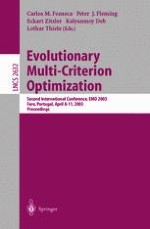2003 | Book
Evolutionary Multi-Criterion Optimization
Second International Conference, EMO 2003, Faro, Portugal, April 8–11, 2003. Proceedings
Editors: Carlos M. Fonseca, Peter J. Fleming, Eckart Zitzler, Lothar Thiele, Kalyanmoy Deb
Publisher: Springer Berlin Heidelberg
Book Series : Lecture Notes in Computer Science
Included in: Professional Book Archive
